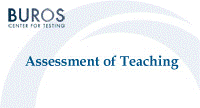Buros-Nebraska Series on Measurement and Testing
Date of this Version
1990
Document Type
Article
Citation
From: Assessment of Teaching: Purposes, Practices, and Implications for the Profession, edited by James Y. Mitchell, Jr., Steven L. Wise, and Barbara S. Plake; Series Editor Jane Close Conoley (Hillsdale, New Jersey, Hove & London: Lawrence Erlbaum Associates, 1990)
Abstract
The first opportunity to use teacher evaluation to improve teaching arises when a student applies for admission into an undergraduate teacher preparation program. At this time it is the responsibility of the program faculty to determine whether each candidate possesses those abilities and other personal characteristics that every teacher needs, but cannot expect to acquire in such a program, and to deny admission to those who lack one or more of them. The second opportunity arises when the student has completed the program. At this time it is the responsibility of the state certification agency to find out whether each candidate has acquired the minimum professional knowledge and skill necessary for certification as competent to enter the teaching profession, and deny certification to those who have not. Additional opportunities arise after the teacher enters into practice and either comes up for tenure or becomes a candidate for merit pay. At either point it is the responsibility of the school administration to ascertain whether the teacher is performing well enough to receive tenure or merit pay and deny them to those who are not.
If the evaluation made at each of these times is valid and is followed by appropriate action, the overall quality of teaching in the schools is expected to improve because incompetent teachers would be systematically eliminated from the profession. In order for this theory to work, each incompetent teacher who is eliminated must be replaced by another teacher who is competent. Thus the success of this strategy depends on the assumption that an ample supply of competent teachers is available to replace those we eliminate, an assumption unlikely to prove true.
There is a second strategy for using teacher evaluation to improve teaching, the success of which does not depend on this rather dubious assumption. This alternative strategy is to increase the competence of the incompetent teachers we already have instead of replacing them. The success of this strategy depends, like that of the first, on the validity of the teacher evaluations used. Unless the procedures used to screen out incompetent teachers are valid, all that the first strategy can do is increase teacher turnover. Unless the evaluation procedures used to upgrade the competence of the teachers we have are valid, all that the second strategy can do is prolong the training some teachers receive.
There are two major questions that must be answered before either of these strategies can be applied with any success. The first of these questions is: What should we evaluate? The second question is: How shall we evaluate it? Only when the first question has been answered is it possible to answer the second. Past efforts to use teacher evaluation to improve teaching have failed, largely because they have tended to neglect the first question and concentrate on the second. Before we can answer either question we must make and preserve careful distinctions in the meanings of four terms too often used interchangeably. These terms are teacher competence, teacher competency, teacher effectiveness, and teacher performance.
Included in
Educational Administration and Supervision Commons, Educational Assessment, Evaluation, and Research Commons


Comments
Copyright © 1990 by Lawrence Erlbaum Associates, Inc. Digital Edition Copyright © 2012 Buros Center for Testing. This book may be downloaded, saved, and printed by an individual for their own use. No part of this book may be re-published, re-posted, or redistributed without written permission of the holder of copyright.